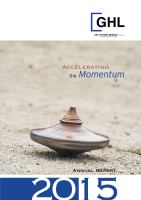

89
GHL Systems Berhad
(293040-D)
Annual report 2015
Notes to the Financial Statements
31 December 2015 (continued)
4.
SIGNIFICANT ACCOUNTING POLICIES (continued)
4.20 Earnings per share
(a) Basic
Basic earnings per ordinary share for the financial year is calculated by dividing the profit for the
financial year attributable to equity holders of the parent by the weighted average number of
ordinary shares outstanding during the financial year.
(b) Diluted
Diluted earnings per ordinary share for the financial year is calculated by dividing the profit for
the financial year attributable to equity holders of the parent by the weighted average number
of ordinary shares outstanding during the financial year adjusted for the effects of dilutive
potential ordinary shares.
4.21 Fair value measurements
The fair value of an asset or a liability, (except for share-based payment and lease transactions) is
determined as the price that would be received to sell an asset or paid to transfer a liability in an orderly
transaction between market participants at the measurement date. The fair value measurement
assumes that the transaction to sell the asset or transfer the liability takes place either in the principal
market or in the absence of a principal market, in the most advantageous market.
The Group measures the fair value of an asset or a liability by taking into account the characteristics
of the asset or liability if market participants would take these characteristics into account when
pricing the asset or liability. The Group has considered the following characteristics when determining
fair value:
(a) The condition and location of the asset; and
(b) Restrictions, if any, on the sale or use of the asset.
The fair value measurement for a non-financial asset takes into account the ability of the market
participant to generate economic benefits by using the asset in its highest and best use or by
selling it to another market participant that would use the asset in its highest and best use.
The fair value of a financial or non-financial liability or an entity’s own equity instrument assumes
that:
(a) A liability would remain outstanding and the market participant transferee would be required
to fulfil the obligation. The liability would not be settled with the counterparty or otherwise
extinguished on the measurement date; and
(b) An entity’s own equity instrument would remain outstanding and the market participant
transferee would take on the rights and responsibilities associated with the instrument. The
instrument would not be cancelled or otherwise extinguished on the measurement date.



















